Metals are shiny, solid, and strong materials that are used for making various objects and structures, such as coins, wires, bridges, and cars. Metals are also good conductors of heat and electricity, which means that they can transfer heat and electric current easily. But have you ever wondered why metals don’t burn, or catch fire, when exposed to heat or flame? Why can you hold a metal spoon over a stove without setting it on fire, while a wooden spoon would quickly burn and char?
Metals: Fire-Resistant Nature
The answer lies in the chemical and physical properties of metals, and how they react with oxygen, the main component of air and fire. Oxygen is a highly reactive element, which means that it can combine with other elements to form new compounds. When oxygen combines with a substance and releases heat and light, we call it burning, or combustion. For example, when oxygen combines with carbon and hydrogen in wood, it forms carbon dioxide and water, and releases heat and light. This is what we see as fire.
However, not all substances react with oxygen in the same way, or at the same rate. Some substances, such as wood, paper, or cloth, react with oxygen easily and quickly, and produce a lot of heat and light. These substances are called flammable, or combustible, and they can catch fire easily. Other substances, such as metals, react with oxygen slowly and weakly, and produce little or no heat and light. These substances are called non-flammable, or non-combustible, and they are hard to burn.
Also read : Predator Or Dinosaur? Scientific Debate Is Fueled By 210-Million-Year-Old Southern African Footprints

There are three main reasons why metals are non-flammable, or hard to burn. First, metals have a high ignition temperature, which means that they need a lot of heat to start reacting with oxygen. For example, iron has an ignition temperature of about 1,500 degrees Celsius, while wood has an ignition temperature of about 300 degrees Celsius. This means that you need to heat iron to a much higher temperature than wood to make it burn. Second, metals are good thermal conductors, which means that they can transfer heat away from the source quickly. For example, when you heat a metal spoon over a stove, the heat from the flame is spread throughout the spoon, and is also lost to the air and the surroundings. This means that the metal spoon does not get hot enough to burn, while a wooden spoon would get hot and burn at the point of contact with the flame. Third, metals have a low surface area to volume ratio, which means that they have a small amount of surface exposed to oxygen compared to their volume. For example, a metal cube has six faces exposed to oxygen, while a metal powder has many tiny particles exposed to oxygen. This means that a metal cube has less chance of reacting with oxygen than a metal powder, and is harder to burn.

However, this does not mean that metals cannot burn at all. In fact, some metals can burn very well under certain conditions. For example, magnesium is a metal that can burn with a bright white flame, and is used in fireworks and flares. Magnesium can burn because it has a low ignition temperature of about 650 degrees Celsius, and because it forms a thin layer of oxide on its surface that protects it from losing heat. When magnesium is exposed to a flame, the oxide layer breaks, and the metal reacts with oxygen rapidly and vigorously, producing a lot of heat and light2. As another example, aluminum is a metal that can burn with a yellow-orange flame, and is used in thermite and rocket fuel. Aluminum can burn because it has a high affinity for oxygen, which means that it can combine with oxygen strongly and exothermically, releasing a lot of heat. When aluminum is finely powdered and mixed with an oxidizer, such as iron oxide, it can ignite and burn with a very high temperature of about 2,500 degrees Celsius, enough to melt iron and steel.

In summary, metals are hard to burn because they have a high ignition temperature, because they are good thermal conductors, and because they have a low surface area to volume ratio. However, some metals can burn very well under certain conditions, such as when they are finely powdered, mixed with an oxidizer, or have a protective oxide layer. Metals are fascinating and versatile materials that can be used for various purposes, and that can also produce spectacular effects when they burn.
Also read : 860 Volts Of Surprise: Unraveling The Peculiar Genetic Impact Of Electric Eels




































